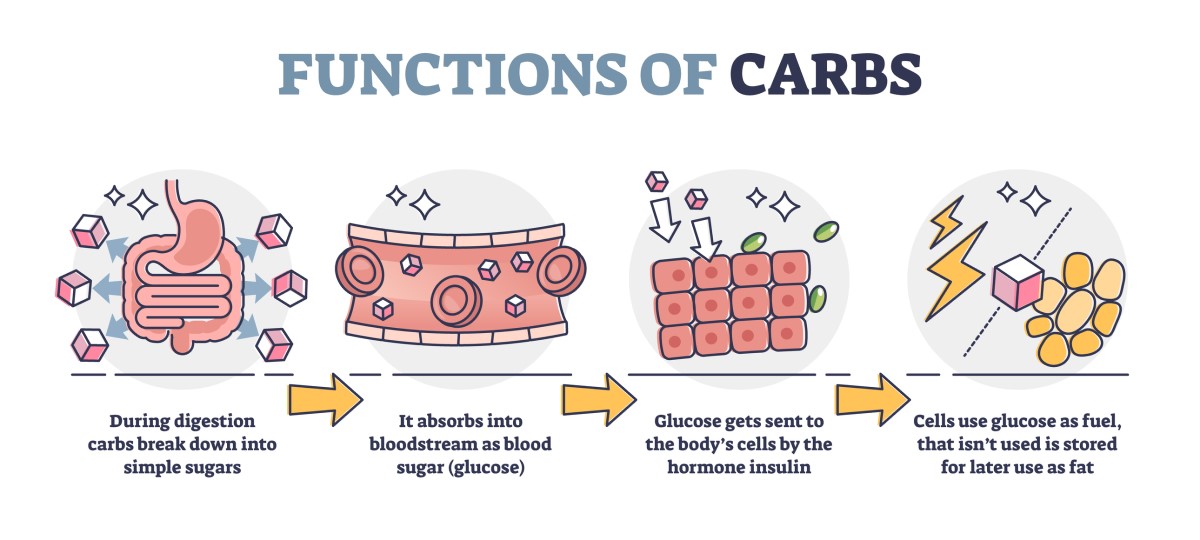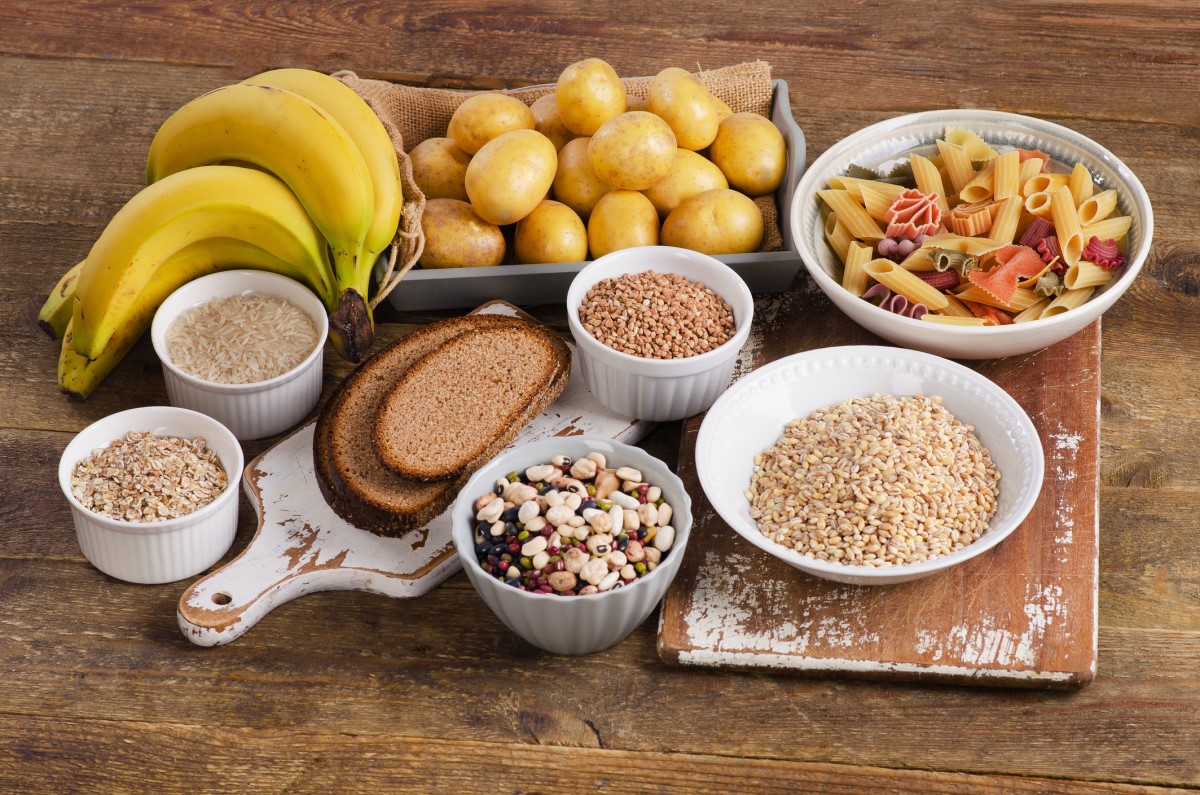- SHARMA, Sangita. Clinical nutrition and dietetics: in a nutshell. Translated by Hana POSPÍŠILOVÁ. Prague: Grada Publishing, 2018. Sestra (Grada). ISBN 978-80-271-0228-0.
- solen.cz - The importance of different types of carbohydrates in children's nutrition. Solen. Eva Kudlová, M.D., CSc.
- healthline.com - Carbohydrates: Whole vs. Refined - Here's the Difference. Healthline. Kris Gunnars, BSc.
- medicalnewstoday.com - What you need to know about carbs. Medical News Today. Jillian Kubala, MS, RD
Carbohydrates: distribution and function in the body + Sources and content of carbohydrates in the diet

Carbohydrates, together with proteins and fats, form the essential macronutrients that our body needs. Why is carbohydrate intake essential for the human body? What foods are good sources of carbohydrates?
Article content
You can learn the classification of carbohydrates, importance, functions, healthy and unhealthy carbohydrates, sources in the diet and many more interesting information in the article.
What is a carbohydrate?
A carbohydrate is an organic compound belonging to the group of polyhydroxy derivatives. It comes from the Latin name saccharum, which translates to sugar. The obsolete technical name is hydrate or carbon hydrate.
Carbohydrates can be divided in several ways.
The basic division of carbohydrates
The basic building unit of carbohydrates is the so-called sugar unit.
According to the number of sugar units, a carbohydrate is divided into 3 groups:
- Monosaccharides (simple sugars)
- Oligosaccharides (complex sugars)
- Polysaccharides (compound/complex)
Monosaccharides
Monosaccharides are the simplest sugars composed of one sugar unit. They are the basic building unit of more complex carbohydrates. They are made up of 3 to 9 carbon atoms.
Their characteristic feature is good solubility in water and sweet taste.
Monosaccharides are divided into:
- Glucose (grape sugar)
- Fructose (fruit sugar)
- Galactose (part of milk sugar)
- Ribose (part of the nucleic acids RNA and DNA)
- Mannose (important for metabolism)
Oligosaccharides
Oligosaccharides contain 2-10 sugar units in a molecule linked by a common glycosidic bond. Depending on the number of units, they are further referred to as disaccharides, trisaccharides, tetrasaccharides, etc.
- Sucrose (rapeseed, cane sugar)
It is formed by the union of glucose and fructose.
- Maltose (malt sugar)
Formed by combining glucose and glucose
Formed from glucose and galactose
Polysaccharides
Complex high-molecular-weight polysaccharides containing more than ten sugar units linked by a glycosidic bond. They are insoluble in water. They have no sweet taste.
According to their digestibility they are classified as digestible, partially digestible and indigestible.
- Starch
- Glycogen (animal starch)
- Inulin (soluble vegetable fibre)
- Fibre (important for the digestive system)
- Cellulose (building substance)
- Pectin
Simple and complex carbohydrates
In the context of diet, you will have come across the term simple and complex carbohydrates. This is essentially a similar division to that mentioned above. It is a division of carbohydrates according to the number of sugar units - simple sugars.
Simple carbohydrates
Simple carbohydrates are smaller and more easily processed molecules. Monosaccharides and disaccharides are included in this group. A monosaccharide is the smallest possible carbohydrate unit that does not break down further. It is therefore an immediate source of energy.
It is more rapidly digestible and has a low satiating effect.
Complex carbohydrates
Complex carbohydrates include oligosaccharides and polysaccharides. Compared to simple carbohydrates, they contain more nutritionally valuable substances. These include mainly fibre.
Complex carbohydrates are absorbed more slowly by the body and therefore have a strong satiating effect.

Dietary intake of carbohydrates: there is no such thing as a carbohydrate
In addition to being divided according to the number of sugar units (simple sugars), carbohydrates are divided according to their nutritional and dietary value into:
- Retrieved from
- Unprocessed
Processed carbohydrates are nutritionally poorer, especially in fiber. Processed carbohydrates are found in sweetened sodas, candy or white bread, etc.
Processed carbohydrates raise blood sugar levels relatively quickly without having a high satiating effect. On the contrary, their consumption even increases the feeling of hunger.
Unprocessed carbohydrates, on the other hand, are found in fruits, vegetables and whole grains. It is unprocessed carbohydrates that are more nutritious and healthier for the body than processed ones.
If we want our diet to be complete and balanced, we need to pay attention to the ratio of macronutrients (fats, proteins, carbohydrates) contained in foods.
Carbohydrates taken from oatmeal, for example, provide about the same amount of energy (calories) as a candy bar. However, complex unprocessed carbohydrates also provide a number of beneficial nutrients, such as fats and fatty acids, which can be absorbed by the body. Fiber, vitamins, and minerals.
On average, carbohydrates should make up 45-50% of your daily energy intake. Of this, up to 10% should be simple sugars.
Excessive intake of simple sugars can cause unwanted increases in cholesterol and insulin resistance. Conversely, a diet high in complex carbohydrates improves cholesterol levels and reduces insulin resistance.
Dietary fiber is an important nutrient that reduces the risk of diabetes, promotes digestive health, and regulates high cholesterol levels.
However, there is no need to be afraid of processed sugars. Just limit them in your regular diet. Unprocessed carbohydrates with their fiber content and strong satiating effect become the primary source.
What is the glycaemic index?
The glycaemic index is a measure of a food's ability to increase glycaemia - the level of glucose in the blood. It is a dimensionless number. On a scale of 0 to 100, it indicates how quickly the sugar in a given food is absorbed into the body and how quickly it affects blood glucose levels.
The main factor in a high glycaemic index is the content of simple sugars (monosaccharides) in the food. Other factors affecting the index value are the fat content, fibre content, acidity and the way the food is processed.
The glycaemic index is abbreviated as GI.
- GI low to 55
- GI medium > 55-70
- GI high > 70
Function and importance of carbohydrates in the body
Carbohydrates are an essential energy fuel for the body.
Carbohydrates taken into the body are broken down in the digestive tract into simple sugars (glucose), which are then released into the bloodstream.
Through the bloodstream, glucose is transported to the cells by the hormone insulin. Sugar is used as energy in the form of ATP (adenosine triphosphate), which is the main source of energy for our body.
Complex carbohydrates take longer to digest because the digestive tract has more work to do to break them down. They are a slow source of energy with a higher satiating effect. Simple carbohydrates are more easily absorbed by the body and are thus a fast source of energy.
If the body has enough glucose (energy), it can store it in the form of glycogen in the liver and muscles. If the body does not need to use glucose from the blood and the glycogen stores are already full, the excess sugars are converted into another energy store, namely fat.
Functions and importance of carbohydrates in the body:
- Primary source of energy
- Energy storage
- Building structural function
- Storage function
- Component of hormones, enzymes and nucleic acids
- Component of biological membranes

Dietary sources of carbohydrates
Although some diets try to avoid them in the diet, carbohydrates are an essential source of energy for the physiological functioning of our bodies. 1 gram of carbohydrates contains 4 kcal.
Simple, fast sugars provide the body with energy almost immediately, but this energy disappears just as quickly. Refined sugars fall into this category, especially those found in sweets, confectionery or sweetened carbonated drinks.
Fruits also contain simple sugars - glucose and fructose. However, their natural origin and vitamin content make them a good source of quick energy.

When complex carbohydrates are digested, energy is released into the body gradually. The fibre found in complex slow carbohydrates forms part of insoluble starches. It is an important part of a complete and balanced diet. It reduces the risk of constipation and bad cholesterol levels.
The daily intake of dietary fibre should be approximately 30 g.
Suitable sources of complex carbohydrates in the diet:
- Oatmeal
- Quinoa
- Potatoes, sweet potatoes
- Beans
- Lentils, peas
- Chickpeas
- Rice
- Bread (rye/wholemeal)
- Couscous, bulgur
- Buckwheat
- Nuts (cashews, peanuts, pistachios)

Interesting resources
Related










